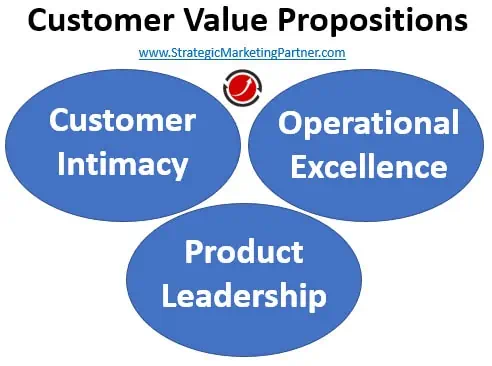What Does a Marketing Consultant Do? (5 skills)
Marketing consultants are the bridge between what your business is now, and what you want your business to become. Core […]
Read More »Become a successful marketing consultant: Learn more

This #shorts video is best viewed on mobile:
The customer value proposition is the strategy a company chooses to separate themselves from the competition.
This is based on how the customer defines value, such as:
The three categories of value proposition are; 1. Customer Intimacy, 2. Operational Excellence, and 3. Product Leadership.
I invite you to read the above sentences again. That’s because if you do not have a strategy to separate yourself from the competition, then this topic really needs to sink in.
In this article we are going to define these three fundamental business models, which are also known as the three categories of customer value propositions.
Let's get started.

The best companies will clearly communicate their value proposition in their targeted advertising campaigns and clearly integrate their customer value proposition in their daily operations.
It is important to not confuse the customer value proposition with the unique selling proposition. While they sound similar and have similar qualities, they are very different. Go here for a very helpful article that explains the difference between the two:
Unique selling proposition vs value proposition (with examples)
Most importantly, the best companies choose one customer value proposition and go ALL-IN, making the other two customer value propositions just ‘good enough’ to compete in the market.
When a company chooses their value proposition strategy, they have important decisions to make that have a profound impact on:
Then, of course, this highly impacts sales and marketing strategies and how messaging is communicated to the customer.
Anyway, here’s a brief definition of each customer value proposition with a link to the full articles and explanations on each topic:
Business that choose the customer intimacy strategy are messaging to their customers, “Choose us because we can customize our products and services to meet your individual needs better than the competition.” Quality flooring service companies, Home Depot and a company like Nordstroms are examples of this strategy. Go here for a more information about the Customer Intimacy Customer Value Proposition.
Companies that say, “We can deliver products and services faster, more conveniently and at lower price” choose the operational excellence value proposition. Snap fitness (cheaper 24-hour key club) and Walmart are examples of this strategy. Go here for a more information about the Operational Excellence Customer Value Proposition.
Companies that choose the product leadership strategy are saying you should choose us because we offer a higher quality product than our competitors. Apple, Orange Theory and Cisco Systems are examples of companies that succeed because of product leadership. Interestingly, product leaders act fast and avoid bureaucracy at all costs because it slows decisions and time to market. Go here for a more information about the Product Leadership Customer Value Proposition.
Deciding how your value proposition fits in the marketplace doesn’t have to be complicated. That’s because most companies have no concrete idea what their value proposition is - and this happens more often than you might think!
For example, it is not uncommon for a fitness business to exploit a market opportunity such as ‘weight loss’ marketed to the over 40 crowd of professional office workers, or an online flooring company, to gain a network of franchisees or dealers to exploit the market. All while not having a clearly defined value proposition. This is not to say that value is not provided to a customer who pays for it — this is to say that a company may not have a clearly defined value proposition.
And this makes your job even easier to gain market share and uncommon profits when you aggressively target and communicate this to the marketplace.
A business that can clearly define their leadership position in at least one category can create a viable reason for why the customer should choose them over the competition. And they can own the market in at least that position.
For example, Anytime Fitness does a good job in communicating their operational excellence to the gym-goers who want a clean, no-frills 24-hour workout, while currently offering a product leadership position to franchise candidates with a higher quality product in this space. Go here for a review of how Anytime Fitness does this and for some other examples.
After all, mastery of one value proposition may eventually become the minimum that a company will need in order to win. But it’s also possible that the biggest winners of the future will have mastered two value propositions -- which we will discuss in future tutorials!
Helpful Resources:
If you have special skills as it relates to developing unique selling propositions and value propositions, you can learn how to turn this into an income as a marketing consultant. Go here to learn how with our Nomad Marketing Starter Guide.